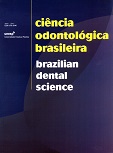Controle da dor após exodontias com a utilização de bupivacaína ou lidocaína: estudo piloto
DOI:
https://doi.org/10.14295/bds.2005.v8i1.180Abstract
Nesta pesquisa buscou-se avaliar, através de um estudo piloto, o grau de dor pós-operatória após exodontias, nas quais foi utilizada anestesia infiltrativa com bupivacaína a 0,5% com epinefrina 1:200.000 ou lidocaína a 3% com norepinefrina 1:50.000. Assim, a amostra foi composta por 14 pacientes de ambos gêneros, com idades que variaram entre 18 e 47 anos, com indicação para duas exodontias na maxila. Foram constituídos grupos controle e experimental, de forma aleatória, onde se considerou como grupo controle a infiltração com lidocaína e como grupo experimental a bupivacaína. Os resultados indicaram que não houve associação significativa entre o tipo de anestésico e a presença de dor pós-operatória para 3 e 6 horas de avaliação, entretanto, esta foi significante para os intervalos de tempo de 12 e 24 horas (P=0,013). Quanto ao uso de analgésico e o tipo de anestésico comprovou-se associação significante para os intervalos de tempo de 6, 12 e 24 horas (P=0,002). Conclui-se que para as primeiras 6 horas de avaliação não existiu diferença em usar bupivacaína e lidocaína em relação a presença de dor pós-operatória. No entanto, a lidocaína nas últimas 12 horas de avaliação mostrou-se ser mais eficaz, contrariando a literatura apresentada.Downloads
Downloads
Published
How to Cite
Issue
Section
License
Brazilian Dental Science uses the Creative Commons (CC-BY 4.0) license, thus preserving the integrity of articles in an open access environment. The journal allows the author to retain publishing rights without restrictions.
=================




























